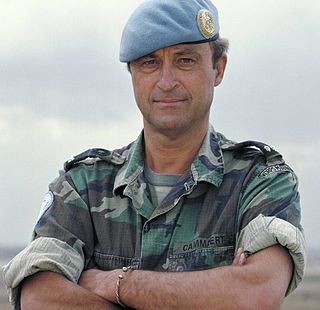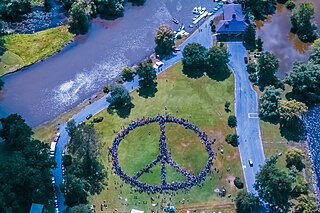
Peacekeeping comprises activities, especially military ones, intended to create conditions that favor lasting peace. Research generally finds that peacekeeping reduces civilian and battlefield deaths, as well as reduces the risk of renewed warfare.

The Convention on the Elimination of all Forms of Discrimination Against Women (CEDAW) is an international treaty adopted in 1979 by the United Nations General Assembly. Described as an international bill of rights for women, it was instituted on 3 September 1981 and has been ratified by 189 states. Over fifty countries that have ratified the Convention have done so subject to certain declarations, reservations, and objections, including 38 countries who rejected the enforcement article 29, which addresses means of settlement for disputes concerning the interpretation or application of the convention. Australia's declaration noted the limitations on central government power resulting from its federal constitutional system. The United States and Palau have signed, but not ratified the treaty. The Holy See, Iran, Somalia, Sudan, and Tonga are not signatories to CEDAW.
Gender mainstreaming is the public policy concept of assessing the implications for people of different genders of a planned policy action, including legislation and programmes. Mainstreaming offers a pluralistic approach that values the diversity among people of different genders.

Major General Patrick Cammaert is a retired Dutch general who served as the United Nations Force Commander for the Eastern Democratic Republic of the Congo. He served since 1968 and graduated in parachuter and commando courses. He was previously the Military Advisor to the Secretary-General of the United Nations. Prior to that position, he was the Force Commander of the United Nations Mission in Ethiopia and Eritrea (UNMEE), as the Military Adviser in the Department of Peacekeeping Operations, and has spent a career in the Royal Netherlands Marines specializing in peacekeeping operations.

Peacebuilding is an activity that aims to resolve injustice in nonviolent ways and to transform the cultural and structural conditions that generate deadly or destructive conflict. It revolves around developing constructive personal, group, and political relationships across ethnic, religious, class, national, and racial boundaries. The process includes violence prevention; conflict management, resolution, or transformation; and post-conflict reconciliation or trauma healing before, during, and after any given case of violence.
The United Nations Peacekeeping efforts began in 1948. Its first activity was in the Middle East to observe and maintain the ceasefire during the 1948 Arab–Israeli War. Since then, United Nations peacekeepers have taken part in a total of 72 missions around the globe, 12 of which continue today. The peacekeeping force as a whole received the Nobel Peace Prize in 1988.

United Nations Security Council resolution 1493, adopted unanimously on 28 July 2003, after recalling all resolutions on the situation in the Democratic Republic of the Congo, the council extended the mandate of the United Nations Mission in the Democratic Republic of Congo (MONUC) until 30 July 2004 and raised its troop level from 8,700 to 10,800.

United Nations Security Council resolution 1509, adopted unanimously on 19 September 2003, after recalling all previous resolutions on the situation in Liberia, including Resolution 1497 (2003), the council established the 15,000-strong United Nations Mission in Liberia (UNMIL) to assist in implementing a ceasefire and peace agreement.

United Nations Security Council Resolution 1960, adopted unanimously on December 16, 2010, after recalling resolutions 1325 (2000), 1612 (2005), 1674 (2006), 1820 (2008), 1882 (2009), 1888 (2009), 1889 (2009) and 1894 (2009), the Council requested information on parties suspected of patterns of sexual violence during armed conflict to be made available to it.

United Nations Security Council Resolution 1983 was adopted unanimously on June 7, 2011, after recalling meetings on HIV/AIDS in Africa and in the mandates of peacekeeping operations, as well as resolutions 1308 (2000), 1325 (2000), 1820 (2008), 1888 (2009), 1889 (2009), 1894 (2009) and 1960 (2010). The Council encouraged the inclusion of HIV/AIDS prevention, treatment, care and support in its peacekeeping mandates.
United Nations Security Council Resolution 1888 was unanimously adopted on 30 September 2009. It was introduced by United States Secretary of State Hillary Clinton, who also presided over the session. The resolution established the United Nations Special Representative on Sexual Violence in Conflict.
The Secretary's Office of Global Women's Issues is located within the United States Department of State. In 2009, Melanne Verveer was appointed to be the first Ambassador-at-Large for Global Women's Issues. From September 2013 to May, 2017, Catherine M. Russell was appointed to this position. From May 2017 through December 2019, there was no ambassador for this office. Kelley Currie, a political appointee, joined the Global Women's Issues Office as U.S. Ambassador-at-Large in January 2020. Geeta Rao Gupta is the current Ambassador-at-Large for the office as of May 18th, 2023.
Gender and security sector reform is an emerging subfield of security sector reform (SSR) that is both practical and conceptual. SSR generally is a comprehensive framework within which all or part of a state's security sector undergoes a process of transformation in order to bring it more into line with principles such as democratic oversight, good governance and the rule of law. The overall objectives of SSR programmes – as defined both by the state in question and any international donors supporting the process – tend to include improving service delivery, enhancing local ownership and ensuring the sustainability of security sector institutions. As gender-specific approaches take into account the specific needs of men, women, boys and girls through gender mainstreaming and by promoting the equal participation of people of all genders in decision-making processes, states and international organisations increasingly consider them to be a necessary component of SSR programmes.
The term international framework of sexual violence refers to the collection of international legal instruments – such as treaties, conventions, protocols, case law, declarations, resolutions and recommendations – developed in the 20th and 21st century to address the problem of sexual violence. The framework seeks to establish and recognise the right all human beings to not experience sexual violence, to prevent sexual violence from being committed wherever possible, to punish perpetrators of sexual violence, and to provide care for victims of sexual violence. The standards set by this framework are intended to be adopted and implemented by governments around the world in order to protect their citizens against sexual violence.
Aisling Swaine is an associate professor of practice of international affairs, focusing on women, security and development at the Elliott School of International Affairs of the George Washington University.

Rachel Grimes is a retired officer of the British Armed Forces. She worked for almost three decades in the security sector. Grimes has deployed on operations with NATO, the United Nations and as a part of a UK national contingent in war and conflict areas in Europe, Asia and Africa. She has worked in security sector reform, counterinsurgency operations and human security in military operations. Initially working in transport, logistics and air defence missile systems. Grimes went on to be the Army's spokesperson in the MOD and deployed as a media operations officer in Iraq in 2003. She has also worked in the area of influence operations and as a doctrine and policy writer. Grimes was part of the NATO Counterinsurgency Writing Group from 2011 to 2013. She worked in the Democratic Republic of Congo with the United Nations Organization Stabilization Mission in the Democratic Republic of the Congo's (MONUSCO's) as the UN Force Commander's Child Protection and Gender Field Advisor in Goma. She deployed to a similar role in Iraq in 2015 and then spent three years at the United Nations HQ in New York acting as a Gender and Child Protection Adviser to the UN Military Adviser. She is keenly aware of the gender dynamics at play in conflict and in peace and has studied the role and contribution of women and military masculinities in Counter Insurgency Operations and the British Army.
The U.S. National Action Plan on Women, Peace, and Security was adopted when President Barack Obama signed an executive order on December 19, 2011, 11 years after the United Nations Security Council adopted United Nations Security Council Resolution 1325 on women, peace, and security. It specified initiatives and activities that will empower and enlist women and girls in efforts to achieve international peace and security. The U.S. NAP was formally revised in June 2016. On June 11, 2019, the White House released the U.S. Strategy on Women, Peace, and Security, which superseded the National Action Plan.

The Office of the Special Representative of the Secretary-General on Sexual Violence in Conflict (OSRSG-SVC) is an office of the United Nations Secretariat tasked with serving the United Nations' spokesperson and political advocate on conflict-related sexual violence, the Special Representative of the Secretary-General on Sexual Violence in Conflict (SRSG-SVC). The Special Representative holds the rank of Under-Secretary-General of the United Nations and chairs the UN Action Against Sexual Violence in Conflict. The mandate of the SRSG-SVC was established by Security Council Resolution 1888, introduced by Hillary Clinton, and the first Special Representative, Margot Wallström, took office in 2010. The current Special Representative is Pramila Patten of Mauritius, who was appointed by United Nations Secretary General António Guterres in April 2017. The work of the SRSG-SVC is supported by the United Nations Team of Experts on the Rule of Law/Sexual Violence in Conflict, co-led by the Department of Peacekeeping Operations (DPO), Office of the High Commissioner for Human Rights (OHCHR) and the United Nations Development Programme (UNDP), also established under Security Council Resolution 1888.
International law encompasses the protection of human rights, in both conflict situations and post-conflict reconstruction. The Convention on the Elimination of All Forms of Discrimination against Women (CEDAW) was adopted by the United Nations General Assembly in 1979 and has the goal of promoting women's rights. Women have contributed to work on the ground in post-conflict reconstruction, aid and ceasefire negotiations. They have also contributed to the Geneva II peace talks regarding Syria, and were involved in the Rohingya conflict in Myanmar as 'front-line responders'. ]










